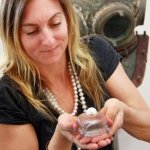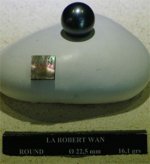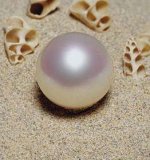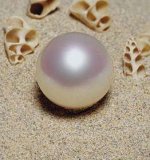Cyril Roger Brossard
Well-known member
- Joined
- Aug 30, 2012
- Messages
- 408
Priceless pearl returns home
An article from 2011 written by Amy Williams, Broome.
Unlike many precious gems you will find in shops on Broome’s Dampier Terrace, this one is not for sale.

Instead, Cygnet Bay Pearls, Australia’s oldest cultured pearl farm (started in 1946), has brought the world’s biggest fine-quality round pearl home to Broome, after its years touring the globe to qualify the claim.
Round, white pearls are the most valuable pearls – and the bigger sizes are the hardest to grow.
This pearl has ticked all five virtues of the pearl: lustre, surface, size, shape and colour. Unblemished, with a sought-after white/ pink hue, it is twice the size of an average South Sea pearl – measuring 22 millimetres and weighing 156 grams. It can now be seen at Cygnet Bay’s new showroom.
In possibly the most official method available to ensure it was the world’s biggest pearl, Cygnet Bay’s distributor Autore Pearls toured the pearl at the prestigious trade fairs over the past six years and found no dispute to the claim.
James Brown, third generation pearl farmer and general manager of Cygnet Bay Pearls, said this was an event of which all of Australia could be proud.
“But it’s also something Broome should be particularly proud of, being the pearling capital of Australia,” he said.
The pearl was harvested at Cygnet Bay pearl farm, on Dampier Peninsula, north of Broome, as part of a bumper crop of large pearls in 2004. Mr Brown said it was a grand culmination of his family’s efforts during almost 50 years developing cultured pearling techniques.
“I remember vividly the day it was harvested – it was jaw-dropping as one of the technicians pulled it out and dropped it onto the table,” he said.
“But its life would have started four years earlier when it was first seeded, and every month after that it was checked, scrubbed and nurtured.
“It’s a long time waiting – and that’s pearling. It’s the ultimate mixture of a group of people’s hard work, but also being totally reliant on the environment and how healthy and happy the animal is keeping.
“You have to be extremely patient, sit through cyclones, never really knowing what you’re going to get, and years later reap the harvest.”
While Cygnet Bay has turned down international offers of millions of dollars, the pearl will remain a prize without price.
“That a shiny little rock could be worth so much is quite a bizarre concept … but until someone grows a bigger one, it is priceless,” Mr Brown said.
Cygnet Bay has long been focused on the international market, but was also developing an affinity with the Australian consumer, who was likely to find confidence in a find such as this.
Underlined in red is the sentence with what I believe is a typographical error.
The correct sentence should have been measuring 22 millimetres and weighing 15.6 grams, unless this pearl is made from a material unknown to earth.
An article from 2011 written by Amy Williams, Broome.
Unlike many precious gems you will find in shops on Broome’s Dampier Terrace, this one is not for sale.

Instead, Cygnet Bay Pearls, Australia’s oldest cultured pearl farm (started in 1946), has brought the world’s biggest fine-quality round pearl home to Broome, after its years touring the globe to qualify the claim.
Round, white pearls are the most valuable pearls – and the bigger sizes are the hardest to grow.
This pearl has ticked all five virtues of the pearl: lustre, surface, size, shape and colour. Unblemished, with a sought-after white/ pink hue, it is twice the size of an average South Sea pearl – measuring 22 millimetres and weighing 156 grams. It can now be seen at Cygnet Bay’s new showroom.
In possibly the most official method available to ensure it was the world’s biggest pearl, Cygnet Bay’s distributor Autore Pearls toured the pearl at the prestigious trade fairs over the past six years and found no dispute to the claim.
James Brown, third generation pearl farmer and general manager of Cygnet Bay Pearls, said this was an event of which all of Australia could be proud.
“But it’s also something Broome should be particularly proud of, being the pearling capital of Australia,” he said.
The pearl was harvested at Cygnet Bay pearl farm, on Dampier Peninsula, north of Broome, as part of a bumper crop of large pearls in 2004. Mr Brown said it was a grand culmination of his family’s efforts during almost 50 years developing cultured pearling techniques.
“I remember vividly the day it was harvested – it was jaw-dropping as one of the technicians pulled it out and dropped it onto the table,” he said.
“But its life would have started four years earlier when it was first seeded, and every month after that it was checked, scrubbed and nurtured.
“It’s a long time waiting – and that’s pearling. It’s the ultimate mixture of a group of people’s hard work, but also being totally reliant on the environment and how healthy and happy the animal is keeping.
“You have to be extremely patient, sit through cyclones, never really knowing what you’re going to get, and years later reap the harvest.”
While Cygnet Bay has turned down international offers of millions of dollars, the pearl will remain a prize without price.
“That a shiny little rock could be worth so much is quite a bizarre concept … but until someone grows a bigger one, it is priceless,” Mr Brown said.
Cygnet Bay has long been focused on the international market, but was also developing an affinity with the Australian consumer, who was likely to find confidence in a find such as this.
Underlined in red is the sentence with what I believe is a typographical error.
The correct sentence should have been measuring 22 millimetres and weighing 15.6 grams, unless this pearl is made from a material unknown to earth.
Last edited:



